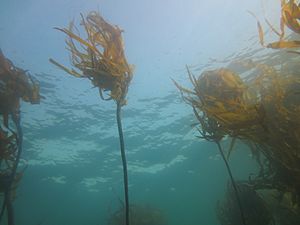Nereocystis facts for kids
Quick facts for kids Nereocystis |
|
|---|---|
 |
|
| Nereocystis luetkeana at Caspar Point, California | |
| Scientific classification | |
| Genus: |
Nereocystis
|
| Species: |
luetkeana
|
Nereocystis (Greek for "mermaid's bladder") is a monotypic genus of subtidal kelp containing the species Nereocystis luetkeana. Some English names include edible kelp, bull kelp, bullwhip kelp, ribbon kelp, bladder wrack, and variations of these names. Due to the English name, bull kelp can be confused with southern bull kelps, which are found in the Southern Hemisphere. Nereocystis luetkeana forms thick beds on subtidal rocks, and is an important part of kelp forests.
Contents
Etymology
The species Nereocystis luetkeana was named (as Fucus luetkeanus) after the German-Russian explorer Fyodor Petrovich Litke (also spelled Lütke) by Mertens. The species was renamed in a description by Postels and Ruprecht.
Description

Individuals can grow to a maximum of 36 m (118 ft). Nereocystis has a holdfast of about 40 cm (16 in), and a single stipe, topped with a pneumatocyst containing carbon monoxide, from which sprout the numerous (about 30-64) blades. The blades may be up to 4 m (13 ft) long, and up to 15 cm (5.9 in) wide. It is usually annual, sometimes persisting up to 18 months. Nereocystis is the only kelp which will drop spore patches, so that the right concentration of spores lands near the parent's holdfast.
The thallus of this common canopy-forming kelp has a richly branched holdfast (haptera) and a cylindrical stipe 10–36 m (33–118 ft) long, terminating in a single, gas-filled pneumatocyst from which the many blades, up to 10 m (33 ft) long, develop. Blade growth can reach 15 cm (5.9 in) per day. Reproductive patches (sori) develop on the blades and drop to the seafloor at maturity.
Distribution
The species is common along the Pacific Coast of North America, from Southern California to the Aleutian Islands, Alaska. However, drift individuals disperse with ocean currents further south into northwest Baja California, Mexico.
This annual kelp grows on rock from the low intertidal to subtidal zones; it prefers semi-exposed habitats or high-current areas. Offshore beds can persist for one to many years, usually in deeper water than Eualaria or Macrocystis, where they co-occur.
See also
 In Spanish: Nereocystis para niños
In Spanish: Nereocystis para niños

